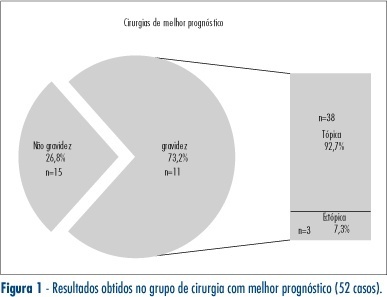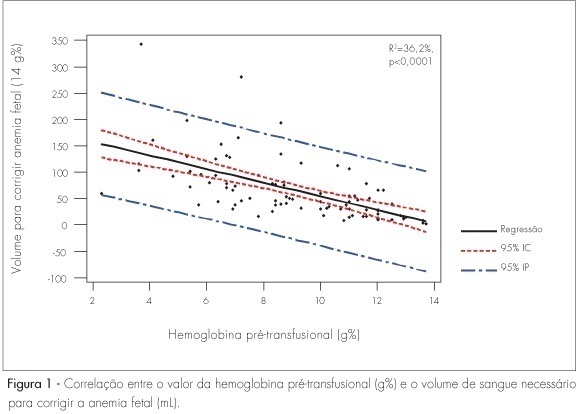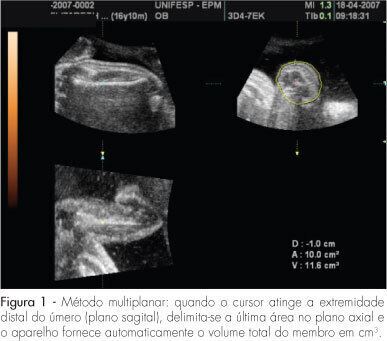Summary
Revista Brasileira de Ginecologia e Obstetrícia. 2008;30(6):294-299
DOI 10.1590/S0100-72032008000600005
PURPOSE: to verify the ratio of intra-uterine gestation in patients submitted to recanalization in the Hospital Regional da Asa Sul in the last 30 years and to assess the rate of ectopic gestation of such procedures, the influence of age and time interval between salpingectomy and recanalization in the therapeutic success. METHODS: medical files of 71 patients were analyzed, after exclusion of those presenting other alterations that could influence fertility prognosis, plus the cases when recanalization was impossible. Variables collected were: occurrence of intra-uterine gestation, coming to term or to abortion; occurrence of ectopic pregnancy after salpingectomy; no-conception after reversion, women's age at the recanalization, and time interval between salpingectomy and its reversion. RESULTS: there has been a pregnancy rate of 67.6%, 73.2% for bilateral recanalization and 46.6% for unilateral, as well as 5.6% of ectopic pregnancies. Concerning the patients' age group, it was observed a pregnancy rate of 33%, from 20 to 24; 60%, from 25 to 29; 69.2%, from 30 to 34; 65%, from 35 to 39, and 42.9%, from 40 to 44 years old. The number of cases was small for age the groups 20 to 24 and 40 to 44 years old. The time interval between salpingectomy and recanalization (TISR) has varied from one to 18 years. TISR has been divided in three groups presenting the following pregnancy rates: one to six year interval, 59%; seven to 12, 66.6%; 13 to 18, 57%. CONCLUSIONS: gestation rate has been 67.6%, 5.6% being ectopic. In the comparison of age groups, there has been no significant influence of age on the therapeutic success of patients from 25 to 39 years old. Sterility duration did not influence the reversion results.

Summary
Revista Brasileira de Ginecologia e Obstetrícia. 2008;30(5):248-255
DOI 10.1590/S0100-72032008000500007
PURPOSE: to describe the socio-demographic characteristics of deaths caused by uterine cervix cancer in women living in Recife, Pernambuco, Brazil, from 2000 to 2004. METHODS: a transversal populational study, including 323 deaths by uterine cervix cancer, among which 261 were recorded in the Information System about Mortality and 62 were identified after investigation on deaths by cancer at non-specified sites of the uterus. Mortality rate for all the variables was obtained and statistics for central tendency and variance were calculated. The χ2 test was performed to obtain the mortality coefficient concerning the living place and age range of the patients. RESULTS: death among women under 60 (54.7%), black (60.5%), single (67.6%), housewives (71.2%) and the ones living in poor neighborhood (53.3%) preponderated. Most of deaths occurred in hospitals (85.1%) and 90.2% of them occurred inside national health system hospitals. The mortality coefficient varied from 0.3 (among women under 30) to 54.9/100.00 (among women over 80). Significant statistical differences (p<0.05) were evidenced when death linked to age range and sanitary district was compared to characteristics of the female population living in the city. CONCLUSIONS: in Recife, death by cervix cancer are more frequent among adult, black, single, housewives, women living in poor neighborhoods and attended to at national health system hospitals, with differences in death risk among age ranges and living place.
Summary
Revista Brasileira de Ginecologia e Obstetrícia. 2008;30(5):241-247
DOI 10.1590/S0100-72032008000500006
PURPOSE: to evaluate the meiotic spindle and the chromosome distribution of in vitro matured oocytes obtained from stimulated cycles of infertile women with polycystic ovary syndrome (PCOS) and with male factor and/or tubal infertility (Control Group) and compare in vitro maturation (IVM) rates between the groups analyzed. METHODS: five infertile patients with PCOS and eight controls, submitted to stimulated cycles for intracytoplasmic sperm injection, were selected prospectively and consecutively, and respectively assigned to the study group and the Control Group. Immature oocytes (21 and 29, respectively, from PCOS and Control Group) were submitted to IVM. After IVM, oocytes with first polar body extruded were fixed and submitted to immunostaining and fluorescence microscopy for morphological evaluation of the spindle and of chromosome distribution. Statistical analysis was performed by the Fisher test with significance, when p<0.05. RESULTS: IVM rates were similar between groups (47.6 e 44.8%, respectively, for PCOS and Control Group). Six of the ten oocytes (60%) from the study group and four of the 12 oocytes (33.3%) from the Control Group presented meiotic anomalies of the spindle and/or anomalous chromosome distribution, without statistical difference between groups. CONCLUSIONS: data from the present study did not demonstrate significant difference neither in IVM rates nor in the proportions of meiotic anomalies between in vitro matured oocytes obtained from stimulated cycles from PCOS patients and control ones.
Summary
Revista Brasileira de Ginecologia e Obstetrícia. 2008;30(5):232-240
DOI 10.1590/S0100-72032008000500005
PURPOSE: to determine caffeine consumption in pregnant women and to evaluate its association with demographic, socioeconomic, reproductive, lifestyle and maternal nutritional status. METHODS: it is a cross-sectional study performed between 2005 and 2007. The present analysis refers to the period among the 8th and 13th gestational week and included 255 pregnant women from 18 to 40 years, clients of a municipal health center in Rio de Janeiro. The outcome variable was caffeine consumption, quantified by a semi-quantitative food frequency questionnaire, which count with a list containing 81 items and eight options of consumption frequencies; besides it being previously validated in a sample of employees of the State University of Rio de Janeiro. The caffeine intake was quantified starting from the consumption of: powdered chocolate, chocolate bar or chocolate, soft drink, coffee and mate tea. The statistical analysis was performed by means of fitting a multivariate linear regression. RESULTS: the median and the mean caffeine consumption were, respectively, 97.5 and 121.1 mg (standard deviation, sd = 128.4). The high caffeine consumption (> 300 mg/day) was observed in 8.3% of pregnant women. It was observed in the multivariate model that women with earlier menarche (β = -0.15), with more household partners (b = 0.17) and who didn’t make use of medicines (β = -0.24) presented larger tendency to high caffeine consumption association that was statistically significant (p <0.05). CONCLUSIONS: the caffeine consumption for most of the pregnant women was inferior to the limit of 300 mg/day as commited in other studies. Tendency was observed toward higher consumption of caffeine in pregnant women with earlier menarche, with more household partners and who didn’t make use of medicines.
Summary
Revista Brasileira de Ginecologia e Obstetrícia. 2008;30(5):224-231
DOI 10.1590/S0100-72032008000500004
PURPOSE: to analyze the association of pregnancy in adolescence with low birth weight (LBW). METHODS: all the patients who gave birth in a teaching Hospital at Maranhão State from July to December 2006 were included in the study and were split in two groups: adolescents (ten to 19 years old) and adults (20 to 34 years old). The variables studied were: skin color, schooling, marital status, family income, number of pre-natal appointments, gestational age at the onset of pre-natal assistance, place where they spend that period, gestation duration, delivery route and birth weight. Data were processed by the Epi-Info program, 3.4.1 version, and the associations between variables were analyzed by the Odds Ratio (OR), with a confidence interval (CI) of 95%. Models of logistic regression were also used. The significance level adopted was 0.05. RESULTS: 1,978 patients were evaluated. A ratio of 25.4% of deliveries in adolescents was observed; they presented low level of schooling, no mates, low number of pre-natal appointments, late onset of pre-natal assistance, low birth weight and prematurity. In the analysis of LBW as end variable, associated to prematurity (OR=29.0), it was clear the association with low number of pre-natal appointments (OR=2.98; 95%CI=2.23-4.00), pre-natal late onset (OR=1.91; 95%CI=1.3-2.6) and low schooling (OR=1.95; 95%CI=1.4-2.5) related to adolescence (OR=1.50; 95%CI=1.1-1.9). Similar results were obtained when the prematurity variable was excluded. Adolescents showed lower incidence of caesarean section (33.3%) than adults (49.4%), a significant difference, besides lower association with pre-eclampsia and cephalo-pelvic disproportion. CONLUSIONS: pregnancy in adolescence was associated to pre-natal late onset and low number of appointments, besides low schooling, low birth weight and a lower incidence of cephalo pelvic disproportion and pre-eclampsia.
Summary
Revista Brasileira de Ginecologia e Obstetrícia. 2008;30(5):219-223
DOI 10.1590/S0100-72032008000500003
PURPOSE: to evaluate the toxicity of tacrolimus on embryonic development in rats treated during the tubal transit period. METHODS: sixty Wistar rats were distributed into four groups (15 animals each), which received different doses of tacrolimus through intragastric administration: (T1) 1.0 mg/kg/day, (T2) 2.0 mg/kg/day and (T3) 4.0 mg/kg/day. The control group (C) received distilled water. The rats were observed daily to detect clinical signs of toxicity. The treatments were performed from the first to the fifth day of pregnancy. The following maternal variables were analyzed: body, ovary, liver, and kidney weights, food intake, number of corpora lutea, implants, alive and dead fetuses, and implantation rates. The fetuses and placentae were weighed and the former were observed in order to detect external malformation. Statistical analysis was performed by one way: analysis of variance (ANOVA), folowed by the Dunnet test (alpha=0.05). RESULTS: there were no signs of maternal toxicity, such as body weight loss, decrease in food intake or in organ weights (p>0.05). There was also no significant difference among weights of fetuses (C: 1.8±0.6; T1: 2.2±0.5; T2: 1.9±0.5 and T3: 2.0±0.5 g) and placentae (C: 1,6±0.4; T1: 1.5±0.4; T2: 1.8±0.4 e T3: 1.6±0.4 g), with p>0.05; no external malformation was detected in the fetuses. CONCLUSIONS: the administration of tacrolimus to pregnant rats during the tubal transit period does not seem to generate any toxic effect to mother or embryo.
Summary
Revista Brasileira de Ginecologia e Obstetrícia. 2008;30(4):196-200
DOI 10.1590/S0100-72032008000400007
PURPOSE: to obtain an equation to estimate the volume of red blood cells concentrate to be infused to correct anemia in fetuses of pregnant women with Rh factor isoimmunization, based in parameters obtained along the cordocentesis previous to intrauterine transfusion. METHODS: a transversal study analyzing 89 intrauterine transfusions to correct anemia in 48 fetuses followed-up in the Centro de Medicina Fetal do Hospital das Clínicas da Universidade de Minas Gerais. The median gestational age at the cordocentesis was 29 weeks and the average number of procedures was 2.1. Fetal hemoglobin was assayed before and after cordocentesis, leading to the volume of transfused red blood cells concentrate. The determination of an equation to estimate the blood volume necessary to correct the fetal anemia was based in the blood volume necessary to raise the fetal hemoglobin in 1 g% (the difference between the final and the initial hemoglobin concentration divided by the transfused volume) and in the volume of the amount necessary to reach 14 g%, in the multiple regression analysis. RESULTS: the concentration of pre-transfusion hemoglobin varied between 2.3 and 15.7 g%. The prevalence of fetal anemia (Hb<10 g%) was 52%. The regression equation obtained in the determination of blood volume necessary to reach the concentration of 14 g% of Hb was: transfusion volume (mL)=18.2 - 13.4 x pre- intrauterine transfusion hemoglobin + 6.0 x gestational age in weeks. This equation was statistically significant (p<0.0001). CONCLUSIONS: the study has shown that it is possible to estimate the transfusion volume necessary to correct fetal anemia, based on easily obtainable parameters: gestational age and level of pre-transfusion hemoglobin.

Summary
Revista Brasileira de Ginecologia e Obstetrícia. 2008;30(4):190-195
DOI 10.1590/S0100-72032008000400006
PURPOSE: to evaluate the accuracy of fetal upper arm volume, using three-dimensional ultrasound (3DUS), in the prediction of birth weight. METHODS: this prospective cross-sectional study involved 25 pregnancies without structural or chromosomal anomalies. Bidimensional parameters (biparietal diameter, abdominal circumference and femur length) and the 3DUS fetal upper arm volume were obtained in the last 48 hours before delivery. The multiplanar method, using multiple sequential planes with 5.0-mm intervals, was used to calculate fetal upper arm volume. Polynomial regressions were used to determine the best equation in the prediction of fetal weight. The accuracy of this new formula was compared with Shepard's and Hadlock's formulas. RESULTS: fetal upper arm volume was strongly correlated to birth weight (r=0.83; p<0.005). Linear regression was the best equation [birth weight=681.59 + 43.23 x fetal upper arm volume]. The fetal upper arm volume mean error (0 g), mean absolute error (196.6 g) and mean percent absolute error (6.5%) were lower than using Shepard's formula; however, the difference did not reach significance (p>0.05). Birth weight predicted by fetal upper arm volume had a mean error lower than Hadlock's formula, but this difference was not statistically significant (p>0.05). CONCLUSIONS: the accuracy of fetal upper arm volume obtained through 3DUS is similar to the accuracy of bidimensional ultrasound in the prediction of birth weight. These findings need to be confirmed by larger studies.
